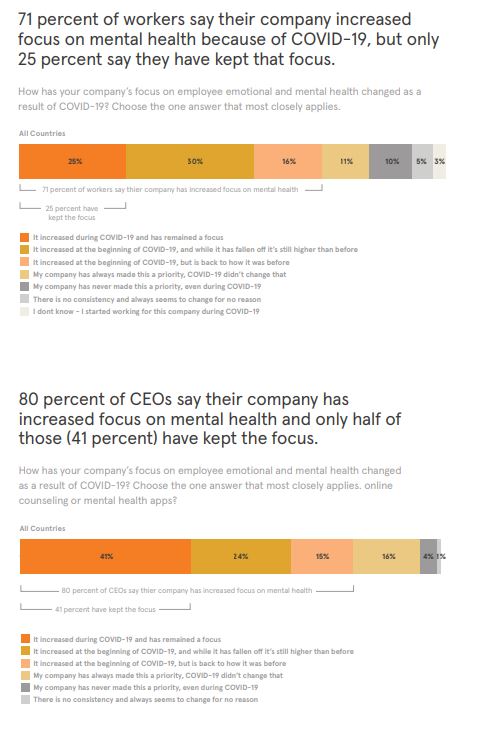Leaders are getting better at championing mental health
But they are still struggling to support employees in the right ways.
Why You Should Care
Wellbeing has climbed up the workplace agenda during COVID-19.
Leaders have never been more open and transparent about their own struggles, but this isn't enough.
Here's how they can ensure workplace mental health offerings are up to scratch.
COVID-19 caused much more than a potentially deadly respiratory disease, it has triggered a mental wellbeing crisis.
In response, employers stepped up and implemented mental health perks and benefits to support employees through the pandemic. They suffered with burnout, social isolation and the grief of losing loved ones to COVID-19.
But two years since the pandemic first started, what does workplace mental wellbeing look like now?
According to a study of more than 5,000 workers by Headspace Health, COVID-19 pushed leaders (and particularly CEOs) to become champions of mental health.
60% of CEOs use mental wellbeing benefits regularly and 65% said they are willing to talk about their mental health in the workplace. The second stat is up from 35% in 2020.
In fact, 30% of CEOs said there was nothing (not even stigma) that would stop them discussing mental wellbeing at work – this is up from 8% in 2021.
Employees appreciate the openness of their leaders, but they still want more from their employers – Headspace Health has termed this the ‘Great Expectation’.
While 94% of CEOs said they did enough to support employee wellbeing, just 67% of employees agree. This is despite CEOs (and employees) acknowledging that mental wellbeing had become less of a focus than it was during the height of the pandemic.

Only 51% of employees ranked their workplace mental health benefits as excellent or very good, compared to 82% of CEOs surveyed.
How to improve mental health offerings
In this context, Headspace Health asked employees what was important for their wellbeing.
52% said a good work-life balance, while 45% said recognition for their work and 38% wanted a culture of kindness. 9 in 10 were clear that they did their best work when they felt valued.
These findings make it clear that employees want to work in a compassionate culture with mindful leadership – 82% of workers want their employers to ask them how they are doing and actually care about the answer.
Employees also want leaders that model good behavior; such as encouraging them to take breaks, and enabling them to switch off from work outside of their working hours.
In addition, employees want more access to easy to use, clinically proven mental health benefits. They also want the offerings to be inclusive of their families because work stress is plaguing their personal lives, and their personal stresses are impacting their work.
Another area that is cropping up more and more is the importance of holistic wellbeing strategies. These must include financial wellbeing offerings, particularly in this climate of record high inflation.
While COVID-19 may still be employees’ biggest stressor (39%), 26% said their personal finances were their biggest concern at the moment.
Of course, the ‘Great Resignation’ is real, and it is stressing employees out – 36% of respondents told Headspace Health that higher workload was their biggest stressor.
So, if employers want to avoid losing anymore staff (or pushing those that remain to exhaustion and burnout and facing an absence crisis), they need to act now to provide the wellbeing support employees need and weaving this in to their retention strategy.
Sign up to the UNLEASH Newsletter
Get the Editor’s picks of the week delivered straight to your inbox!

Chief Reporter
Allie is an award-winning business journalist and can be reached at alexandra@unleash.ai.
